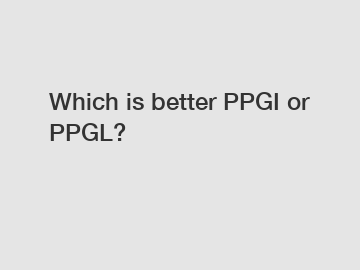Which is better PPGI or PPGL?
When it comes to choosing the right material for your project, it can be overwhelming to navigate through the vast array of options available in the market. PPGI (Pre-Painted Galvanized Iron) and PPGL (Pre-Painted Galvalume) are two popular choices for a variety of applications, ranging from roofing and cladding to appliances and automotive parts. Both materials offer unique features and benefits, but which one is better? Let's delve into a comparison of PPGI and PPGL to help you make an informed decision.
PPGI is made from galvanized steel, which is coated with a layer of zinc to protect it from corrosion. The steel is then pre-painted with a layer of polyester paint, providing a durable and attractive finish. On the other hand, PPGL is made from galvalume steel, which is a combination of galvanized steel and aluminum-zinc alloy. This alloy offers better corrosion resistance compared to traditional galvanized steel, making PPGL a more robust option for outdoor applications.
One of the key differences between PPGI and PPGL lies in their corrosion resistance properties. While both materials offer protection against rust and corrosion, PPGL has a higher resistance to environmental factors such as moisture, UV rays, and chemicals. This makes PPGL the preferred choice for projects that are exposed to harsh weather conditions or corrosive substances, such as coastal buildings or industrial structures.

In terms of aesthetics, both PPGI and PPGL offer a wide range of color options and finishes to suit your design preferences. However, PPGL tends to have a smoother and more uniform surface finish due to its superior coating technology, which can enhance the overall appearance of your project. Additionally, PPGL is available in a variety of metallic finishes that can add a touch of sophistication and elegance to your design.
When it comes to durability, both PPGI and PPGL are known for their long-lasting performance and low maintenance requirements. The pre-painted coatings on both materials provide protection against fading, chipping, and peeling, ensuring that your project retains its vibrant color and finish for years to come. However, PPGL's superior corrosion resistance gives it an edge in terms of longevity, especially in challenging environments where corrosion is a common concern.
Another important factor to consider when choosing between PPGI and PPGL is their cost-effectiveness. While PPGL may have a higher initial cost compared to PPGI due to its advanced coating technology, it offers better long-term value by reducing maintenance and replacement costs. The superior durability and corrosion resistance of PPGL can help prolong the lifespan of your project, ultimately saving you money in the long run.
In conclusion, both PPGI and PPGL have their own merits and applications, depending on your specific project requirements. If you need a durable and corrosion-resistant material for outdoor or industrial applications, PPGL is the better choice due to its superior performance in challenging environments. On the other hand, if you are looking for a cost-effective option with a wide range of color options, PPGI may be more suitable for your needs.
Ultimately, the decision between PPGI and PPGL boils down to your project's specific requirements, budget, and design preferences. It is always advisable to consult with a professional contractor or supplier to determine the best material for your project based on its unique characteristics and performance attributes. By weighing the pros and cons of PPGI and PPGL, you can make an informed decision that aligns with your project goals and ensures a successful outcome.
For more information, please visit PPGI Prepainted Steel Coil For Solar Energy, Galvalume Steel Coil for dryer, Pattern printed steel.
218
0
0

Comments
All Comments (0)